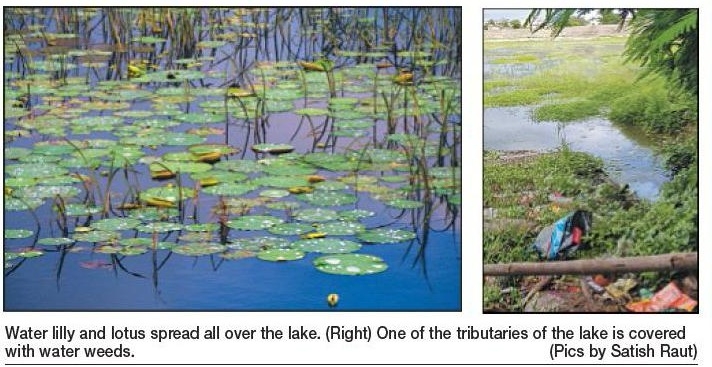Sakkardara lake exploited by anthropogenic activities: Experts
| Date :14-Sep-2021 |

By Kaushik Bhattacharya :
Desilting, identifying traditional tributaries, removal of water hyacinth, stopping sewage are needed to conserve this 200-year-old lake
RAPID urbanisation has posed a serious threat to wetlands in the city. The prime example of this is the Sakkardara lake. Even the existing lakes have become unfit as sources of drinking water due to the growth of water hyacinth and other aquatic weeds and encroachments. The Environment Status Report (ESR) of Nagpur prepared by CSIR-NEERI stated that city lakes, including Sakkardara, were mainly used for recreational activities besides being exploited by unprecedented anthropogenic activities. Slum settlements are located on the banks of the lake and the habitants are using the readily available lake water for washing, bathing and other domestic activities.

It also mentioned that the banks of the lake were seen loaded with garbage dumps. As this lake is containing various kinds of plants like water lily, lotus and macro-algae it indicates its nutrient status. “Excess use of ground water by nearby residents through bore-wells near the lake is a possible reason of depleting water level in Sakkardara lake. Proper survey of number of bore-wells in the locality is needed,” a senior scientist of CSIR-National Environmental Engineering Research Institute (CSIR-NEERI) told ‘The Hitavada’ on condition of anonymity. “Restricting the traditional storm water flow through concretisation is another reason behind low water level in the lake. Instead of constructing retaining walls the civic body should first identify the traditional storm water inlets and rejuvenate for better flow during monsoon,” the scientist said.
A recent study by Green Vigil Foundation and EarthEcho International revealed that the water level of Sakkardara lake was quite low and most of its area was covered by water hyacinth. “Sakkardara lake is in real bad shape. Dissolved oxygen level is 3 mg/l, which can not sustain any ecosystem. The lake is covered with water lily, grass and weeds,” said Surbhi Jaiswal, Team Lead, Green Vigil Foundation. ‘The Hitavada’ noticed some cement pipes abandoned near the newly-constructed retaining wall. “There is a possibility of discharging of untreated sewage from surrounding directly into lake. Sewage contains Nitrogen and Phosphorus which acts as a substrate for growth of these weeds,” said Jaiswal. According to ESR of CSIR-NEERI, “Nutrient pollution in Sakkardara lake is also high.
Nitrogen and phosphorus are nutrients that are natural parts of aquatic ecosystems. It supports the growth of algae and aquatic plants, which provide food and habitat for fish. But when too much nitrogen and phosphorus enter the environment - usually from a wide range of human activities - the air and water can become polluted. And the same thing is happening with this lake.” Kaustav Chatterjee, Founder, Green Vigil Foundation said, “Sakkardara lake had dried up during this summer, thus, there was a golden opportunity for desilting the lake, which we missed. Along with desilting, the water holding capacity of the lake also needs to be increased. Testing of water of nearby wells is recommended in order to evaluate ground water pollution.” Similarly, water hyacinth and other aquatic weeds make water unfit for drinking by humans and livestock. It creates dense mats of biomass on water surface which are reducing light to submerged vegetation, can cause oxygen depletion and fish kills. These aquatic weeds also cause significant increase in water loss due to evaporation.